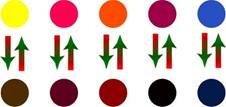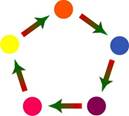home
 information
information  experimental design
experimental design
When planning microarray experiments, there are several important factors to consider, including the experimental design itself, replicates (reciprocal labelling; technical and biological replicates) and sources of variation.
 Expand all
Expand all
 Hide all
Hide all
- Reference Design
-
The reference design is one of the first and still the most popular design for 2-colour microarray experiments. A common reference sample is used in one channel of the microarray and the experimental sample is used in the other channel. As each sample is compared to the common reference, the ratios of signal for a particular gene can be compared between samples or treatments. This method has become increasingly popular with the release of products such as Stratagene's Universal Reference RNA (human, mouse and rat). Other companies, such as ArrayIt and Clontech are now making universal reference RNAs as well.

Advantages
- Widely used
- Easy to set up, analyse and interpret
- Nearly all software packages are compatible
- Highly scalable
- Possible to add new samples later
Disadvantages
- Direct experiments (no reciprocal labelling) lead to possible dye effects which confound biological effects.
- The majority of data collected is actually for the reference RNA which is not of interest biologically.
- All measurements between samples are indirect (via a reference intermediate).
- Paired-Control Design
-

Advantages
- Relatively easy to set up
- Easy to analyse and interpret
- Several software packages are compatible
- Scalable
- Possible to add new samples later
Disadvantages
- Direct experiments (no reciprocal labelling) lead to possible dye effects which confound biological effects.
- Requires a properly matched control.
- Added difficulty when trying to compare between treatments.
- Loop Design
-
First introduced by Kerr and Churchill (2001) Biostatistics 2:183-201

Advantages
- Highly efficient design
- No reference sample required
- All measurements made are on samples of interest
- Dye bias can be isolated from biological effects
Disadvantages
- Direct experiments (no reciprocal labelling) lead to possible dye effects which confound biological effects.
- Increasing numbers of samples leads to increased distances of measurements
- Many of the measurements must be indirect
- Very few software packages are available that are compatible
- Scalability is an issue
- Addition of new samples at a later date difficult
- Network (All Pairs Design)
-
First introduced by Yang and Speed (2002) Nature Rev. Genetics, 3:579-588


Advantages
- Reduces the amount of variance in measurements
- Minimises the distance between measurements
- No reference sample required
- All measurements made are on samples of interest
Disadvantages
- Direct experiments (no reciprocal labelling) lead to possible dye effects which confound biological effects.
- Does not scale well
- Very few software packages are available that are compatible
- Addition of new samples at a later date is very difficult

